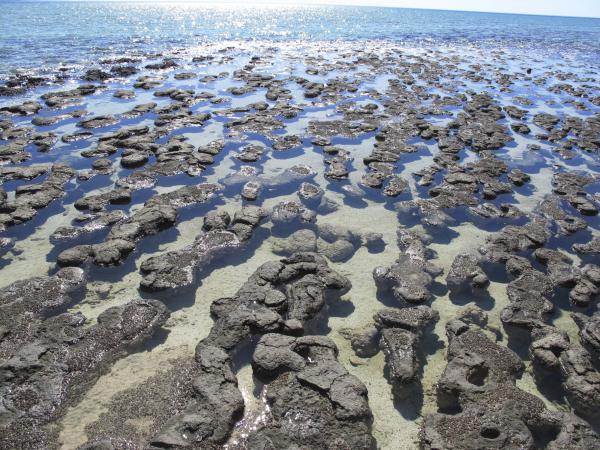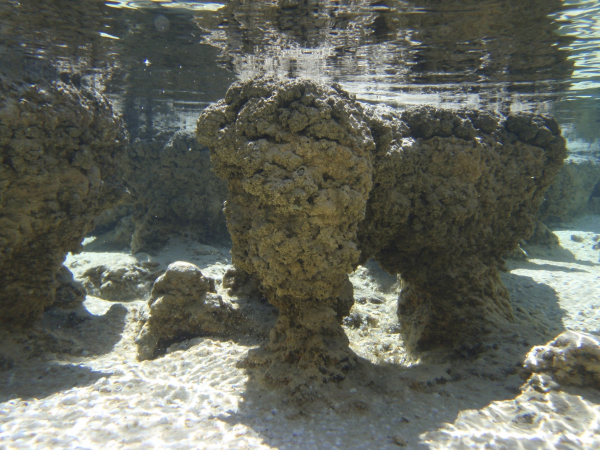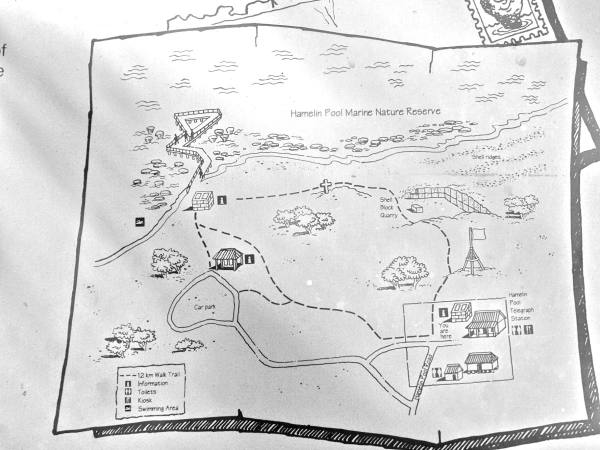
What is a
stromatolite?
A stromatolite, literally meaning ‘layered rock', is a solid
structure created by single-celled microbes called cyanobacteria
(blue-green algae). The cyanobacteria form colonies and trap
sediment with their sticky surface coatings. The trapped sediment
reacts to calcium carbonate in the water to form limestone. These
limestone deposits build up very slowly – it can take a
stromatolite 100 years to grow 5 cm. A one meter high stromatolite
might be 2,000 years old!
Shark Bay’s stromatolites are found around the shallows of
Hamelin Pool, located in the southern part of the eastern bay.
Between 4,000 to 6,000 years ago a massive seagrass bank called the
Fauré Sill began to block tidal flow into Hamelin Pool, causing the
water to become extremely concentrated, or hypersaline. The water
in Hamelin Pool is twice as salty as water in the open ocean!
Animals that would normally graze on algae, such as chitons and
snails, cannot survive in these conditions. Around 3,000 years ago
cyanobacteria started flourishing, forming stromatolites much as
they did billions of years ago. Hamelin Pool contains the most
diverse range of stromatolites in the world, with more than 50
species of cyanobacteria.

What do they look
like?
Stromatolites look like a cross between a cauliflower and a rock.
However, unlike rocks they are actually alive – each
stromatolite has a top surface layer teeming with living, active
cyanobacteria. Cyanobacteria are plants, they photosynthesise their
energy from the sun. A by-product of photosynthesis is oxygen, and
if you look very carefully you may see the stromatolites gently
‘fizzing’ as tiny bubbles of oxygen are released by the
cyanobacteria into the water.
The size and shape of stromatolites are thought to be influenced by
their immediate environment. Large mushroom-shaped stromatolites
may form in places where tides and small waves approach from
different directions. Loaf-shaped stromatolites are found in
protected areas close to the shore. Because cyanobacteria need
sunlight to photosynthesise, the stromatolites in Hamelin Pool do
not form in water deeper than 4 meters, where there is less
light.
Why are they so
important?
Shark Bays’ stromatolites are significant because they
represent a major stage in the Earth’s evolutionary history,
one of the reasons for Shark Bay's World Heritage listing. When the
stromatolites were discovered by scientists in 1956, they were the
first ever recorded living examples of structures previously found
only as fossils in ancient rocks. Although Shark Bay’s
stromatolites are just 2,000 – 3,000 years old, the
cyanobacteria that build them are similar to life forms found on
Earth up to 3.5 billion years ago!
Back then, the Earth’s atmosphere contained only 1%
oxygen. The cyanobacteria dominated the primordial seas, forming
extensive stromatolite reefs and releasing increasing amounts of
oxygen into the atmosphere. Meanwhile, between 2 billion and 1.7
billion years ago, two types of bacteria merged to form a
single-celled organism called a eukaryotic microbe. This more
complex cell established the essential building block for the later
evolution of higher life forms. By about 500 million years ago the
oxygen level had risen to 21% of all atmospheric gases, and the
oceans teemed with oxygen-breathing life forms – including
the first fish. Thus, Shark Bay’s modern stromatolites help
explain the role of microbes in the evolution of the Earth’s
biosphere.
Stromatolites also provide a record of local environmental
changes and even the Earth’s own evolution as a planet. The
sediment layers accumulate in fine concentric bands, like the
growth rings on a tree. Cross-sections of ancient stromatolites
reveal beautiful layers of fossilised sediment. Because
stromatolite growth is controlled by tides, temperature and
sunlight, some scientists believe the sediment layers reflect
changes in the Earth’s rotation on its axis, the tilt of its
axis and the planet’s orbit around the Sun. In this way the
stromatolites of Shark Bay provide not only a unique insight into
life at the dawn of time, but also a modern-day diary of our
changing planet.
The above information is taken from
http://www.sharkbay.org/default.aspx?WebPageID=228
Caring for
Stromatolites
Stromatolites grow along the shore, usually right up to the highest
tide mark. Closer to the shore you will see soft spongey black mats
that are built by cyanobacteria, these are known as tufted mat and
pustular mat stromatolites, in deeper water you will find
cauliflower and club stromatolites. They are all fragile and can be
easily damaged if you touch or walk on them. Please help protect
the stromatolites by walking on the boardwalk or shell beach.

To claim this Earthcache you must
email me (sideandheek@me.com) the answers to the following
questions and then post a picture of your visit to the
Stromatolites. The answers to all the questions can be found at the
given co-ordinates and on the information panels along the
boardwalk.
1. According to "The Hamelin
Telegraph" what are Stromatolites?
2. What is the name of the feature
at the entrance to Hamelin Pools?
3. What are there few of in Hamelin
Pool to allow the Stromatolites to grow and why?
4. When did the red capped
Stromatolites stop growing and what are the reasons given for there
colour?
5. What visible scarring can be seen
in the living tufted stromatolite mats and pustular stromatolite
mats?
6. What's responsible for shaping
the club-shaped stromatolites in deeper water?
7. What do stromatolites produce,
and what are they responsible for in the evolution of our
planet?